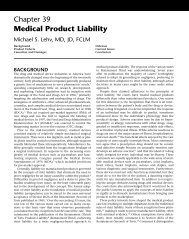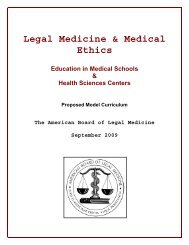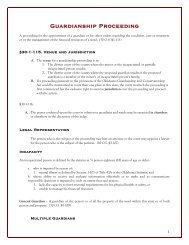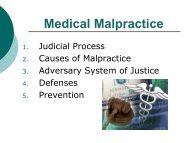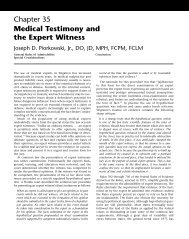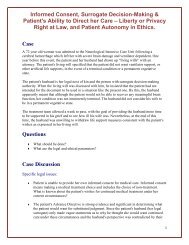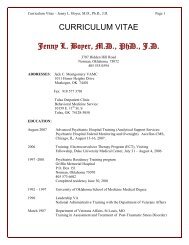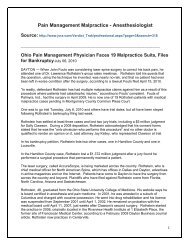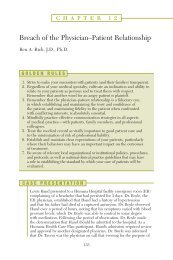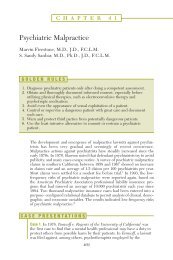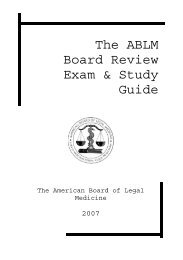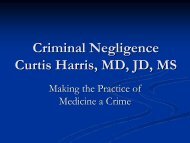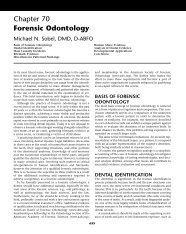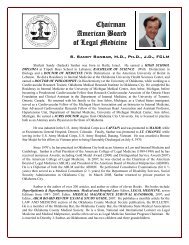Chapter 65 Forensic Engineering - Legal Medicine and Medical ...
Chapter 65 Forensic Engineering - Legal Medicine and Medical ...
Chapter 65 Forensic Engineering - Legal Medicine and Medical ...
Create successful ePaper yourself
Turn your PDF publications into a flip-book with our unique Google optimized e-Paper software.
Ch<strong>65</strong>-A03753 12/14/06 12:04 PM Page 610<br />
610 <strong>Forensic</strong> <strong>Engineering</strong><br />
facts <strong>and</strong> data left at the accident scene in conjunction<br />
with the appropriate natural laws of physics, i.e., the laws<br />
of classical mechanics stated by Sir Isaac Newton in 1687.<br />
The obvious is worth stating: Newton was not thinking<br />
about vehicular accident reconstruction since cars <strong>and</strong><br />
other modern vehicles were not going to be invented for<br />
more than 200 years. Although the laws of classical<br />
mechanics apply to the motion of all bodies in the universe,<br />
Newton was interested in planetary motion, concepts of<br />
gravity, <strong>and</strong> the development of the associated mathematical<br />
descriptions. With regard to accident reconstruction, the<br />
significance of this is that only qualified engineers <strong>and</strong><br />
physical scientists should be retained to do accident reconstructions,<br />
since they are generally thoroughly educated in<br />
underst<strong>and</strong>ing <strong>and</strong> properly applying the laws of physics.<br />
Caution is in order, since the advent of user-friendly computer<br />
programs <strong>and</strong> the codification of the laws of physics into<br />
“cookbook” type manuals have seen the entry of many less<br />
qualified people into the accident reconstruction field, which<br />
often does not serve the interests of truth <strong>and</strong> justice.<br />
General statements of Newton’s laws, which are formulated<br />
for a particle, are stated below, with more detailed<br />
information given in some of the references (Greenwood,<br />
Beer & Johnston, Yeh & Abrams):<br />
■ First law. Every material body continues in its state of<br />
rest, or of constant velocity motion in a straight line,<br />
unless acted upon by external forces that cause it to<br />
change its state of rest or motion.<br />
■ Second law. The time rate of change of linear momentum<br />
(product of mass times velocity) of a particle is proportional<br />
to the external force acting on the particle <strong>and</strong><br />
occurs in the direction of the force. An alternative form<br />
of this law, which is the more commonly stated form, is<br />
that the resultant force acting on a particle is equal to<br />
the mass times the acceleration.<br />
■ Third law. To every action there is an equal <strong>and</strong> opposite<br />
reaction. Or equivalently, the mutual forces of two bodies<br />
acting upon each other are equal in magnitude <strong>and</strong><br />
opposite in direction.<br />
Although Newton’s laws appear to be simple statements,<br />
it must be emphasized that there are significant concepts<br />
<strong>and</strong> sophisticated philosophy embedded in the laws,<br />
which must be mentioned <strong>and</strong> which are essential to an<br />
underst<strong>and</strong>ing <strong>and</strong> proper application of Newton’s laws.<br />
First, the laws are vector statements, which means that the<br />
magnitude <strong>and</strong> direction of forces, velocities, <strong>and</strong> accelerations<br />
must be considered <strong>and</strong> not merely their magnitudes.<br />
Second, “motion” <strong>and</strong> “rest” are relative terms that establish<br />
a frame of reference to which the motion of bodies is<br />
referred. For vehicular accident reconstruction calculations,<br />
the Earth is a suitable fixed reference. However, for space<br />
flights, rocket launchings, <strong>and</strong> general astronomical applications,<br />
the Earth would not be a suitable fixed reference<br />
<strong>and</strong> it would be more accurate to use a distant star. Third,<br />
Newton’s laws mention forces without ever defining them.<br />
Force is a very abstract concept <strong>and</strong> nobody has ever seen<br />
a force, which is the action of one body on another. In automobile<br />
accidents, apart from forces due to gravity, forces on<br />
occupants only arise when an occupant is decelerated<br />
(accelerated) such as by contacting another surface or is<br />
restrained by a seat belt, air bag, another person, etc.<br />
Fourth, Newton’s laws are stated only for a particle, which<br />
by definition is a mathematical point of constant mass. It<br />
requires a rigorous derivation to extend Newton’s laws to<br />
deformable bodies of finite size such as a crashing automobile.<br />
Unfortunately, this is often not appreciated by unqualified<br />
accident reconstructionists, who may tend to erroneously<br />
oversimplify an analysis. Fifth, the concept of systems of<br />
units is defined by Newton’s second law. In the SI system,<br />
mass is given in kilograms (kg), acceleration in meters per<br />
second squared (m/s 2 ), <strong>and</strong> force is the defined unit in<br />
Newtons (N), where one Newton equals one kg-m/s 2 .<br />
In the US–British system of units, force is given in pounds<br />
(lb), acceleration in feet per second squared (ft/s 2 ), <strong>and</strong><br />
mass is the defined unit in slugs, where one slug is equal to<br />
one lb-s 2 per ft.<br />
The general philosophy employed in accident reconstruction<br />
is to work backward from the final positions of<br />
the vehicle(s), to the point(s) of impact or beginning of the<br />
occurrence, <strong>and</strong> if sufficient information exists, prior to<br />
the impact(s) or occurrence. Calculations, either by h<strong>and</strong><br />
or by computer, are performed using the available data in<br />
conjunction with Newton’s laws. Often Newton’s laws are<br />
cast in other forms for convenience, such as the work–energy<br />
principle or impulse–momentum principle (see references<br />
previously cited). In collision problems at the moment of<br />
impact, the impulse–momentum principle is particularly<br />
useful since the resultant external force acting on the<br />
system of colliding bodies is zero. This then leads to the<br />
principle of conservation of linear momentum (product of<br />
mass times velocity), which states that the linear momentum<br />
of a system of colliding bodies is conserved at impact.<br />
This principle, combined with the information left at the<br />
accident scene <strong>and</strong> the vehicle data, is often sufficient to<br />
solve for the velocities of the vehicles at impact. Examples<br />
of the application of the principle of conservation of linear<br />
momentum, along with the associated vector concepts <strong>and</strong><br />
mathematics, are given in Batterman & Batterman (2000),<br />
Beer & Johnston, <strong>and</strong> the SAE Accident Reconstruction<br />
Technology Collection. It should also be mentioned that<br />
numerous commercially available computer programs exist<br />
for accident reconstruction calculations <strong>and</strong> these programs<br />
will not be discussed herein. The programs are based on<br />
Newton’s laws, as they must be, <strong>and</strong> many of them contain<br />
algorithms specialized for accident reconstruction, e.g., crush<br />
damage considerations. As indicated earlier, some of the<br />
programs are so user-friendly that it is possible for unqualified<br />
people, who do not have an adequate educational background<br />
<strong>and</strong> who do not underst<strong>and</strong> their own limitations<br />
as well as those of the programs, to obtain solutions that<br />
may not be valid for a particular accident.<br />
Another aspect of accident reconstruction, <strong>and</strong> undoubtedly<br />
the most difficult, is to determine how an occupant<br />
moves with respect to the crashing vehicle, i.e., the occupant<br />
kinematics. The determination of an occupant’s kinematics<br />
is often critically related to the injuries that may<br />
have been sustained by the occupant. In order to determine<br />
the complete occupant kinematics, an enormous amount



